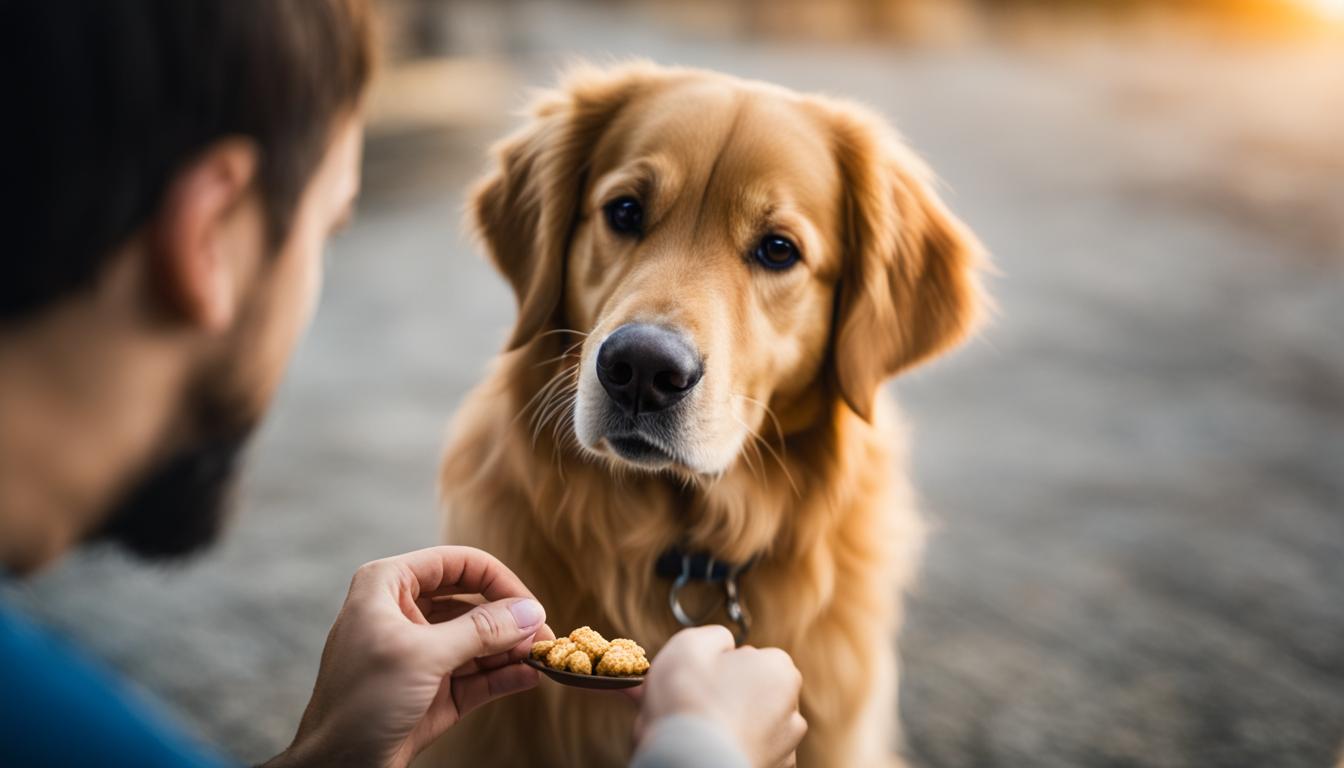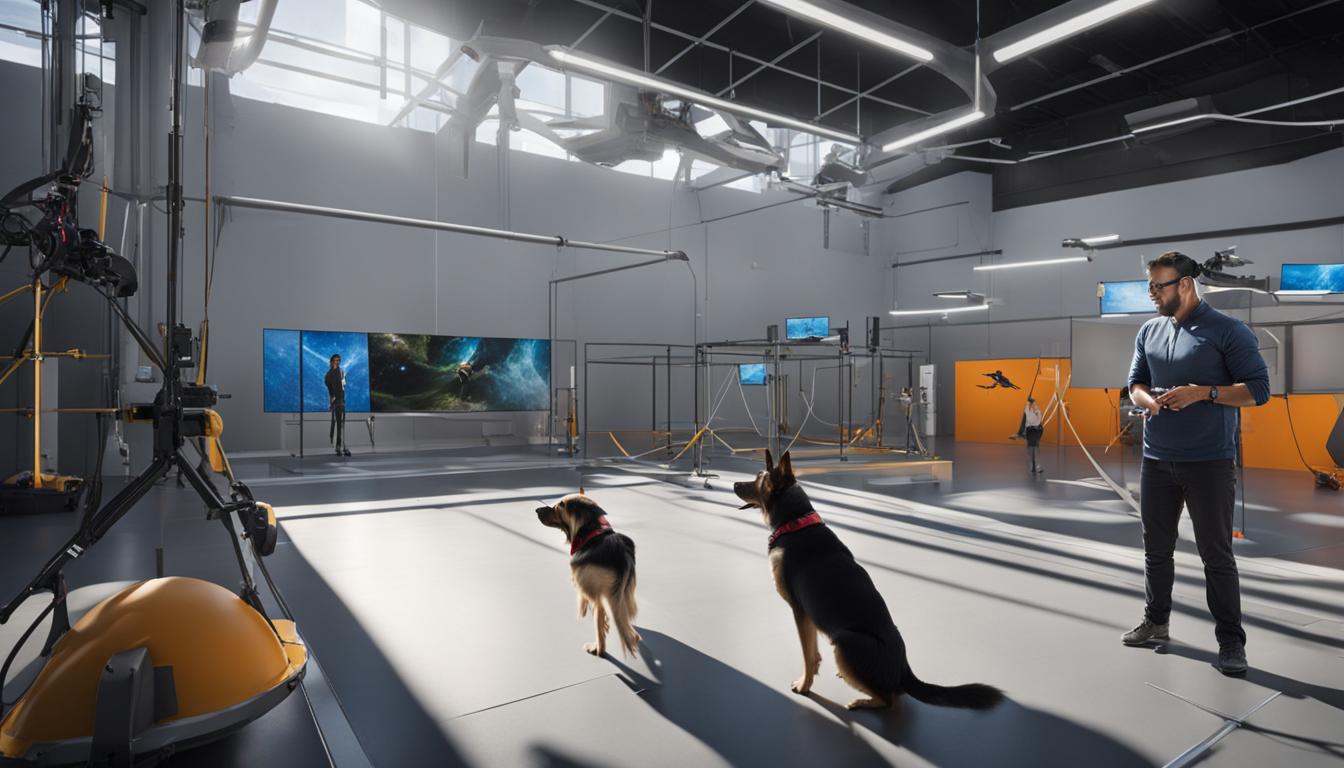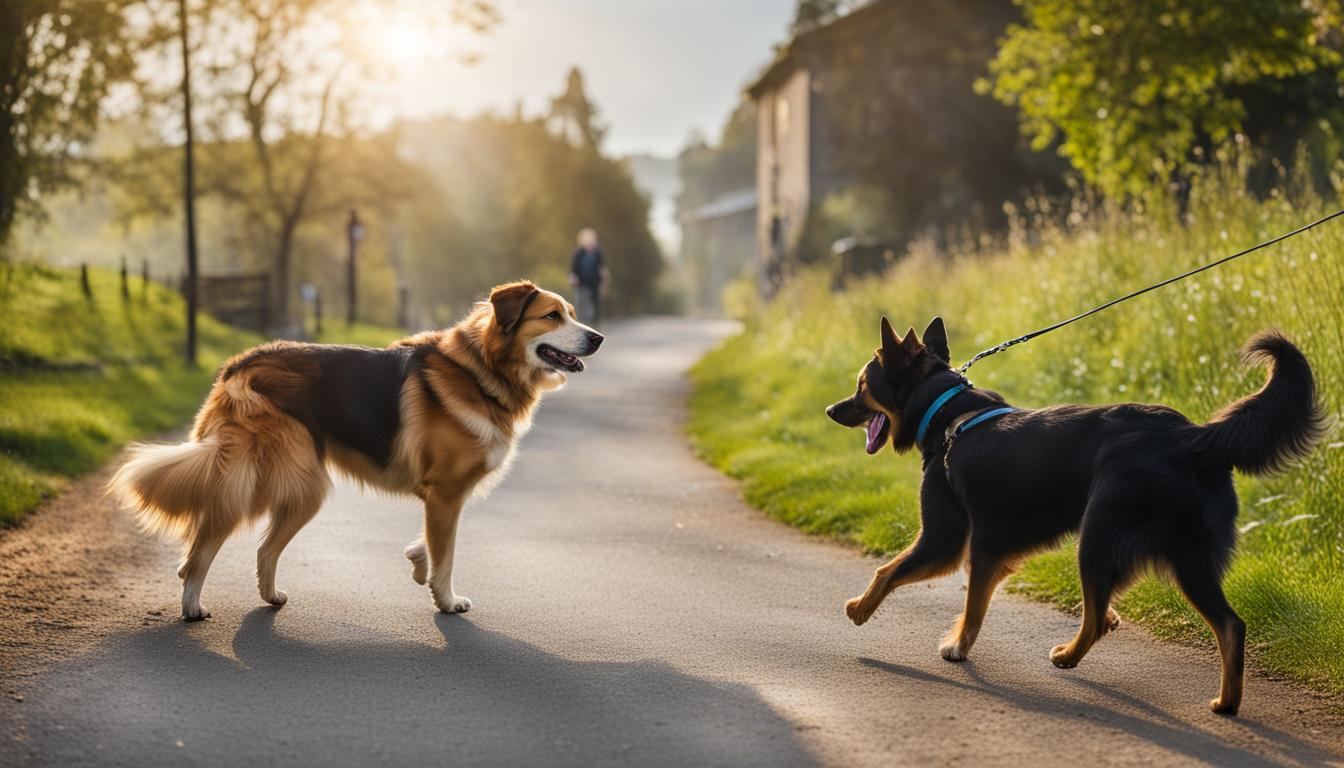Reward-based dog training is a highly effective method for teaching and reinforcing desired behaviors in dogs. When using positive reinforcement, timing is crucial. The reward must be given immediately after the desired behavior to ensure that the dog associates the reward with the correct action. Keeping verbal cues short and consistent is also important for clear communication with your dog. Consistent use of rewards and avoiding inadvertently rewarding unwanted behaviors are essential for successful reward-based training.
Key Takeaways:
- Timing is crucial in reward-based dog training. Give the reward immediately after the desired behavior to reinforce the connection.
- Keep verbal cues short and consistent for clear communication with your dog.
- Avoid inadvertently rewarding unwanted behaviors to maintain the effectiveness of reward-based training.
- Choose rewards that are appealing to your dog, such as food treats or toys, and ensure variety to prevent boredom.
- Strike a balance between rewards and discipline to create a well-behaved and obedient dog.
Types of Rewards in Dog Training
When it comes to dog training, rewards are a powerful tool for motivating and reinforcing desired behaviors. There are various types of rewards that can be used to effectively train your dog, including both food and non-food options.
Rewarding Dogs with Food
Food treats are one of the most commonly used rewards in dog training. Most dogs are highly food-motivated, making treats a valuable tool for positive reinforcement. When using food rewards, it’s important to choose small, soft treats that can be quickly consumed. This allows for seamless training sessions without interruptions. Additionally, using a variety of treats can help prevent your dog from becoming bored with the same reward every time.
Exploring Non-Food Rewards
While food rewards are highly effective, some dogs may be motivated by other forms of positive reinforcement. Toys, play sessions, or petting can also serve as rewarding experiences for your dog. It’s essential to determine what rewards are most appealing to your dog and incorporate them into your training routine. By understanding your dog’s preferences and providing a diverse range of rewards, you can keep them engaged and motivated throughout the training process.
Pairing Verbal Praise with Rewards
In addition to food and non-food rewards, verbal praise plays a vital role in reinforcing positive behaviors. When training your dog, it’s important to pair verbal cues or commands with rewards to create a strong association. For example, when your dog successfully performs a desired behavior, such as sitting on command, immediately reward them with a treat while simultaneously praising them with a clear and enthusiastic “Good job!” This combination of verbal praise and rewards enhances the effectiveness of positive reinforcement in training.

Table: Reward Timing and Frequency Guidelines
| Training Stage | Reward Type | Timing | Frequency |
|---|---|---|---|
| Initial Training | Food Treats | Immediate | Every time |
| Intermediate Training | Food Treats, Verbal Praise | Immediate | Intermittent |
| Advanced Training | Verbal Praise, Toy Rewards, Play Sessions | Immediate | Intermittent |
Training Dogs Without Over-Rewarding
While rewards are an essential part of dog training, it is crucial to strike a balance and avoid over-rewarding your furry companion. Over-rewarding can lead to unwanted behaviors and an excessive reliance on rewards, making it challenging to maintain discipline. To achieve this balance, customizing rewards to your dog’s preferences is key.
Every dog has unique preferences when it comes to rewards. Some may be highly motivated by food treats, while others may respond better to toys or praise. By identifying what motivates your dog the most, you can tailor the rewards to their liking. This customization not only keeps your dog engaged and motivated but also prevents overindulgence, ensuring that rewards remain exciting and meaningful.
Gradually reducing the frequency of rewards as your dog becomes proficient in a behavior is another effective strategy to prevent over-rewarding. Once your dog has learned a behavior consistently, you can start phasing out the rewards gradually. This helps to reinforce the behavior as a habit rather than relying solely on external rewards. Remember, the ultimate goal is for your dog to perform the desired behaviors willingly and without constant rewards.
Customizing Rewards to Dog Preferences
Here are some tips for customizing rewards based on your dog’s preferences:
- Observe your dog’s reactions to different types of rewards and note which ones generate the highest level of excitement.
- Experiment with a variety of rewards, including food treats, toys, play sessions, and petting.
- Use a combination of rewards to keep training sessions engaging and prevent your dog from getting bored with the same treat every time.
- Pay attention to your dog’s body language and enthusiasm during training to determine if the current reward is effective.
By customizing rewards to your dog’s preferences and gradually reducing their frequency, you can ensure that rewards remain a valuable tool in training without over-rewarding. This approach will help you build a strong bond with your dog while instilling good behaviors for a lifetime.
| Reward Type | Description |
|---|---|
| Food Treats | Small, soft treats that can be quickly consumed and highly motivating for most dogs. |
| Toys | Interactive toys or play sessions that provide both mental and physical stimulation. |
| Praise | Verbal affirmations and petting as a form of reward for desired behaviors. |
Balancing Rewards and Discipline
When it comes to dog training, finding the right balance between rewards and discipline is crucial. Rewards are essential for reinforcing positive behaviors, while discipline helps discourage unwanted behaviors. By striking this balance, you can create a well-behaved and obedient dog.
To maintain the balance, it’s important to set clear boundaries and consistent rules for your dog. This provides them with a sense of structure and clarity. Rewarding desired behaviors, such as sitting on command or walking nicely on a leash, helps reinforce these actions. On the other hand, unwanted behaviors should be ignored or redirected to discourage their repetition.

Verbal cues or commands can be paired with rewards to further reinforce desired behaviors. For example, when teaching your dog to stay, you can use the command “stay” and reward them when they successfully do so. This association helps your dog understand what’s expected of them and increases the likelihood of them repeating the desired behavior.
Remember, consistency is key. Stick to your rules and ensure everyone in the household is on the same page. This helps prevent confusion for your dog and ensures they receive consistent training. Balancing rewards and discipline is a dynamic process. As your dog progresses in their training and becomes more proficient, you can gradually reduce the frequency of rewards while still providing occasional reinforcement to maintain their motivation.
Reward-Based Training Success Stories
Ready to be inspired by some incredible reward-based training success stories? These heartwarming tales will show you just how effective and enjoyable this training approach can be.
Meet Max, a mischievous rescue pup who struggled with obedience. Max’s owner, Sarah, decided to give reward-based training a try. Through consistent use of treats and praise, Max quickly learned to sit, stay, and come on command. With each successful training session, Max’s confidence grew, and he became a well-behaved dog who brought joy to Sarah’s life.
Then there’s Lucy, a high-energy Labrador Retriever who loved to jump on people. Lucy’s owner, Mike, implemented reward-based training to curb her jumping behavior. By rewarding Lucy for keeping all four paws on the ground, Mike successfully transformed her into a polite greeter. Now, Lucy’s enthusiastic tail wagging and friendly demeanor make her the star of the neighborhood.
Finally, we have Bella, a stubborn Beagle who had a knack for escaping from the backyard. Bella’s owner, Amanda, turned to reward-based training to keep her safe. By rewarding Bella for staying within the boundaries, Amanda turned her little escape artist into a patio-loving pup. Now, Bella enjoys her outdoor adventures while Amanda enjoys peace of mind.
See the magic of reward-based training unfold!
These stories are just the tip of the iceberg – reward-based training has transformed countless dogs and their owners’ lives. By implementing this positive and effective approach, you can build a strong bond with your furry friend while achieving impressive results. So, grab those treats, put on your training hat, and embark on a journey of success with reward-based training!
FAQ
How do I choose the right rewards for dog training?
The most common rewards used in dog training are food treats, but some dogs may be motivated by toys, play sessions, or petting. It’s important to determine what rewards are most appealing to your dog to keep them engaged and motivated.
When should I give the reward during training?
The reward should be given immediately after your dog performs the desired behavior to ensure they associate the reward with the correct action. Timing is crucial in positive reinforcement training.
How often should I reward my dog during training?
Initially, it’s recommended to reward your dog every time they exhibit the desired behavior, known as continuous reinforcement. Once your dog has consistently learned the behavior, you can switch to intermittent reinforcement, gradually reducing the frequency of rewards.
How can I prevent over-rewarding my dog?
To prevent over-rewarding, it’s important to customize rewards to your dog’s preferences. Pay attention to what motivates them the most, whether it be food treats, toys, or other forms of positive reinforcement. Gradually reducing the frequency of rewards as your dog becomes proficient in a behavior can also help prevent over-rewarding.
How can I balance rewards and discipline in training?
Setting clear boundaries and consistent rules for your dog is essential. Rewarding desired behaviors while ignoring or redirecting unwanted behaviors can help establish this balance. Using verbal cues or commands paired with rewards can also reinforce desired behaviors.
Are there any success stories with reward-based training methods?
Yes, countless dog owners have experienced success with reward-based training methods. These methods have been effective in teaching basic obedience cues as well as more advanced tricks and skills. Reward-based training fosters a deep bond between dogs and their owners while promoting a fun and stress-free learning experience.





